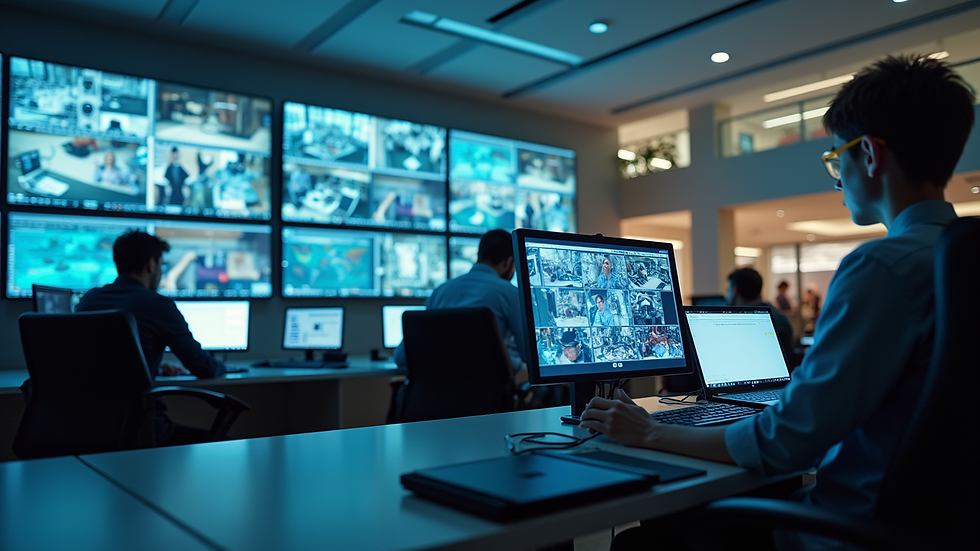Ensuring Safety in Busy Retail Environments
- Ben
- Oct 4
- 3 min read
Busy retail environments like shopping malls are vibrant hubs where thousands of people gather daily. These spaces offer a variety of shops, eateries, and entertainment options, making them attractive but also challenging to secure. Ensuring safety in such bustling areas requires a comprehensive approach to mall security that protects shoppers, employees, and assets alike.
The Importance of Mall Security in Retail Environments
Retail environments are prone to various safety risks, including theft, vandalism, crowd control issues, and emergencies such as fires or medical incidents. Effective mall security is essential to:
Prevent crime: Visible security presence deters shoplifting, vandalism, and other criminal activities.
Manage crowds: During sales or events, controlling the flow of people reduces accidents and chaos.
Respond to emergencies: Quick action in case of fire, medical emergencies, or threats can save lives.
Enhance customer experience: Shoppers feel safer and more comfortable, encouraging longer visits and repeat business.
For example, during holiday seasons, malls often see a surge in visitors. Without proper security measures, this can lead to overcrowding and increased theft. Security teams must be prepared to handle these situations efficiently.

Key Strategies for Effective Mall Security
Implementing a robust security plan involves multiple layers of protection and coordination. Here are some practical strategies:
1. Trained Security Personnel
Having well-trained security officers on-site is the backbone of mall security. They should be skilled in:
Conflict resolution
Emergency response
Surveillance monitoring
Customer service
Security personnel should patrol regularly and be stationed at key points such as entrances, exits, and parking lots.
2. Surveillance Systems
Closed-circuit television (CCTV) cameras provide real-time monitoring and record incidents for later review. Cameras should cover:
Entrances and exits
High-traffic areas
Parking facilities
Emergency exits
Regular maintenance and upgrades ensure the system remains effective.
3. Access Control
Limiting access to restricted areas like storage rooms and staff-only zones prevents unauthorized entry. This can be achieved through:
Key cards or biometric scanners
Security checkpoints
Visitor registration systems
4. Emergency Preparedness
Malls must have clear emergency protocols, including:
Fire evacuation plans
Medical emergency response teams
Communication systems for alerting shoppers and staff
Regular drills and training keep everyone prepared.
5. Collaboration with Local Authorities
Establishing strong relationships with police, fire departments, and medical services ensures quick assistance when needed.
What is the security system in shopping malls?
Shopping malls typically employ integrated security systems combining technology and human resources. These systems include:
Video Surveillance: High-definition cameras with night vision and motion detection capabilities.
Alarm Systems: Sensors on doors, windows, and safes that trigger alerts during unauthorized access.
Public Address Systems: For announcements and emergency instructions.
Incident Reporting Software: Enables security teams to log and track incidents efficiently.
Security Control Rooms: Centralized hubs where security staff monitor all systems and coordinate responses.
For instance, a mall might use facial recognition technology to identify known shoplifters or persons of interest. This proactive approach helps prevent incidents before they escalate.

Enhancing Safety Through Technology and Innovation
Modern malls are adopting advanced technologies to boost security effectiveness:
Artificial Intelligence (AI): AI-powered cameras can detect unusual behavior or crowd density changes.
Drones: Used for aerial surveillance in large outdoor shopping centers.
Mobile Apps: Allow shoppers to report suspicious activity or request assistance quickly.
Smart Lighting: Automated lighting systems improve visibility in parking lots and less trafficked areas.
These innovations not only improve safety but also optimize resource allocation by focusing attention where it is most needed.
The Role of Shopping Mall Security in Customer Confidence
A secure shopping environment builds trust and encourages patronage. When customers know that a mall prioritizes their safety, they are more likely to:
Spend more time shopping
Return for future visits
Recommend the mall to others
Retailers also benefit from reduced losses due to theft and vandalism, creating a win-win situation.

Best Practices for Retailers to Support Mall Security
Retailers play a crucial role in maintaining a safe environment. They can:
Train staff to recognize and report suspicious behavior.
Keep store entrances clear and well-lit.
Use anti-theft devices on merchandise.
Cooperate with mall security during incidents.
Participate in safety drills and meetings.
By working together, retailers and mall security create a safer shopping experience for everyone.
Final Thoughts on Maintaining Safety in Retail Spaces
Ensuring safety in busy retail environments requires a multi-faceted approach. Combining trained personnel, advanced technology, clear protocols, and collaboration creates a secure atmosphere. Continuous evaluation and adaptation to emerging threats keep malls safe and welcoming.
Investing in comprehensive mall security is not just about protecting property - it’s about safeguarding people and fostering a positive community space where commerce and enjoyment thrive.




Comments